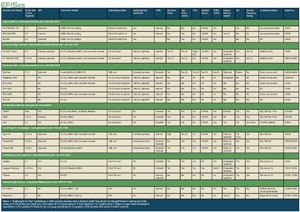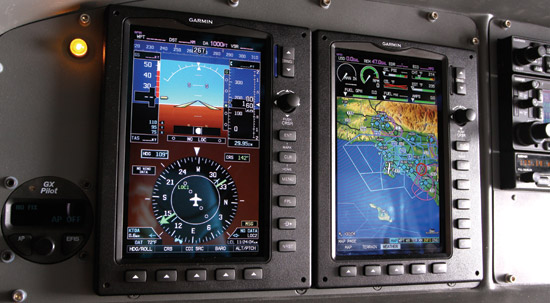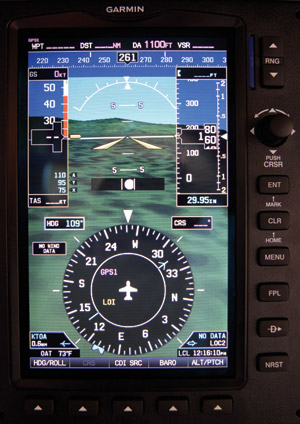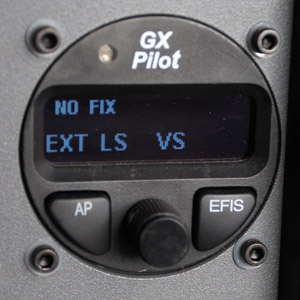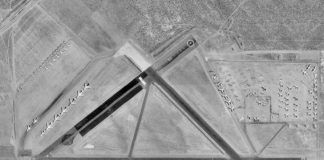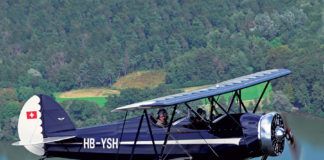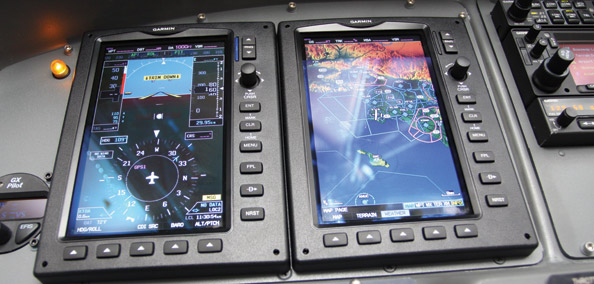
Electronic flight instrument systems (EFISes) have moved beyond the novelty. This is now a mature, stable market that still embraces innovation, but at the same time has edged toward the middle. Features that used to set individual products apart are expected and provided almost universally-synthetic vision, built-in or available redundancy, navigator and autopilot compatibility, and interoperability. As builders of Experimental aircraft, we may bask in the wealth of affordable technology.
As the industry evolves, only the strong survive. Blue Mountain Avionics is no longer in business; Chelton, once a powerhouse at the high end, has largely pulled back from our market; OP Technologies has faded from view. Meanwhile, the established companies thrive. Dynon, the darling of the low-cost set, has introduced a new line of upscale instruments (though still Dynon priced); Advanced Flight Systems and Grand Rapids Technologies continue to introduce new products and features; South African MGL Avionics, which can really no longer be called an upstart, continues with rapid product development. Then there’s Garmin, the irresistible force in avionics, methodically filling out its lineup for homebuilders with the G3X, which now appears in the field in decent numbers.
No doubt new companies will join the existing ones. For example, TL Electronics has been showing a nice looking EFIS and engine monitor at airshows, but the Czech company has little foothold in the market so far. Aspen Avionics, as we shall see, has finally noticed Experimentals, though its debatable whether the current product line is ideal for us.
New Products, Familiar Ideas
Lets reiterate the maturation process. Todays EFISes have a lot of proven technology. The solid-state sensors that underpin the attitude computations have been amazingly reliable, as have many of the supporting sensors. For the most part, EFIS failures have been at the hands of installation errors or software glitches. Whats more, all of the current EFIS products allow for a comprehensive degree of interoperability. Where serial ports used to be in short supply, they are plentiful now. (The Garmin G3X, for example, has two ARINC ports standard plus three RS-232 ports for each display.)
Redundancy is still desirable, and all of the good systems have the ability to provide independent power-bolstered by internal batteries or, for some, products like the TCW Technologies IBBS backup battery. Some support multiple AHRS (attitude/heading reference system) modules, while others can be installed so that each screen in a multiple-screen setup has its own AHRS that is automatically networked.
Purchase Decisions
Always the most difficult aspect to pin down, and one of the questions Im asked most often is: Which EFIS should I buy? First, look at your panel real estate. Will the screens fit? (Clever builders can find ways to make remote modules work; its one of the more pleasurable challenges.) How big can you go? (Bigger is almost always better.) What is your mission? Lets face it, a VFR-minded pilot does not need a serious-IFR panel.
Is an autopilot in your future? Today, the connection between autopilot and EFIS is more intertwined than ever. In some cases, like Dynon, which builds its own servos and wont, as yet, support data output to other autopilots, there is no separation.
Without any further delay, lets have a closer look at the offerings.
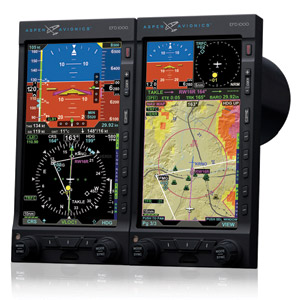
Aspen Avionics EFD duo.
Aspen Avionics
You have probably seen the Aspen before: The configuration is a tall, vertical rectangle with the guts of the system intended to fit into conventional gyro holes. Aspen intended its modular lineup to fit into existing panels in certified aircraft with a minimum of modifications, which is not to say no changes.
One footprint does many jobs. As a single-screen PFD (primary flight display), the Evolution 1000 includes an internal AHRS, traditional tape-based attitude display, an HSI (horizontal situation indicator) and a moving map. You can add the EFD1000 MFD (multifunction display) for a more detailed moving map; it has its own AHRS set for redundancy. Any combination of the three screens can be installed to suit your budget, including the 500 series MFD. Satellite weather is optional.
Originally the company was cool (almost frigid) to homebuilders and to the idea of installing its products in Experimentals. But in the past year we have started to see that philosophy change somewhat, and as a result more homebuilders are choosing this equipment for their projects. Prices are dear: The non-moving-map EFD1000 Pilot is $5995, while the version with a moving map and an HSI is $9995. The MFD with its own AHRS set is $7995. The EFD500 MFD is $4995.
From my perspective, the Aspen is a great product in an uncompromising layout. If you are planning on an upgrade using your existing panel, you’ll want to ensure that the hole spacing will work with the Aspen. Homebuilders go their own way, and there is often little consistency among panel designs for any given aircraft. And if you have to cut a new panel anyway, you might as well take advantage of some of the larger, less expensive screens.
Steins DIY installation rating: Unknown. No installations have yet been done.
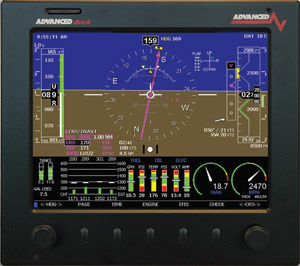
Advanced Flight Systems AF-4500.
Advanced Flight Systems
In the past year we’ve finally started to see deliveries of the delayed and long awaited Advanced Flight DEK (AF-4500) system. A decision by AFS to delay delivery in order to update the system to a newer/later/faster processor turns out to be a good decision, as the entire AFS lineup now includes the faster processor. The 4500s are available in a few formats, either as a standalone EFIS, standalone engine monitor or combination of both, along with a separate MFD. With a new processor comes a host of new functionality and snazzy looking screens. Advanced Flights synthetic vision includes runways, obstructions, active traffic, a newly refined flight director and multiple options for the CDI (course deviation indicator) and HSI.
Additional features of the new system are a better designed full IFR topographical map complete with intersections, private airports, airspace, roads/highways, cities and all of the other features youd expect in an IFR-capable EFIS. Geo-referenced approach plates (where your airplane flies around the approach plate) are also available on the latest systems. With the addition of the optional XM weather module, the main map becomes a powerful map with incredible situational awareness.
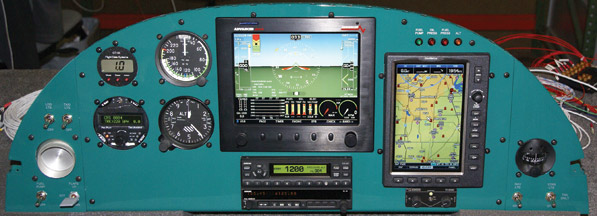
Advanced Flights AF-3500 with synthetic vision and engine monitoring in an RV-8 panel.
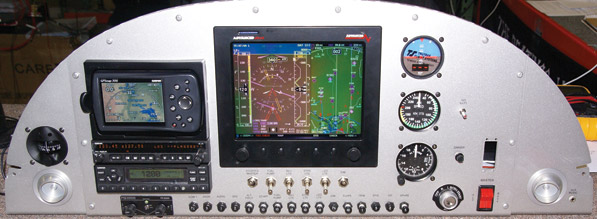
By including the primary flight instruments, moving map and engine monitoring into a single box (in this case an AFS AF-4500), even a normally crammed RV-8 panel looks spacious.
AFSs offerings include the AF-4500 with an 8.4-inch display, the AF-3500 with the same size display but a different bezel mount and one fewer knob on the front, and the AF-3400, which is like the 3500 but with a 6.5-inch display. Moreover, AFS offers each format as a standalone EFIS, an EFIS with integrated engine monitor, an MFD only or a demi-EFIS (pitot/static but no attitude) with engine monitor. Phew. Check out the company’s web site to fully understand all of the permutations.
In 2009, AFS partnered with autopilot manufacturer TruTrak Flight Systems to produce an expanded and branded autopilot specifically for AFS called the AF Pilot. The autopilot now can be controlled entirely through the EFIS while maintaining the benefit of having a standalone autopilot for backup. As expected in a full IFR-capable system, the autopilot will fly coupled GPS approaches but also synthesizes an output to fly coupled ILS/LOC and VOR approaches.
My perspective is that AFS is working hard to catch up with demand and, finally, holding off introducing new product while the pipeline is being filled. Thats a sure sign of maturity.
Steins DIY installation rating: The only remote module to install is the remote compass (as each system has), but everything else is included in the core screens. Advanced Flight provides two complete ready-made plug/play harnesses, which simplify installation even more. Multiple screens are simply connected with an Ethernet cable, as is the add-on optional weather module.
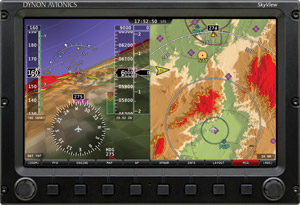
Dynon Avionics 10-inch SkyView.
Dynon Avionics
SkyView is Dynons first step away from its low-cost roots. The modular SkyView system is a clean-sheet design with screen sizes of 7 or 10 inches diagonally. Synthetic vision and moving maps are new for the company. Both screens are wide-aspect-ratio landscape formats, which allow for the data displayed on the screen to be split horizontally. The new screens are well made with buttons that are much more tactile and solid feeling than on the older products.
Where Dynon began with all-in-one architecture, SkyView is quite modular. The screens carry the major processors, but everything else is remote. The AHRS modules include the electronic gyros, pitot/static sensors and magnetometer; you can have one or two of these boxes in the system. Another module connects to the engine sensors; the connectors are pin-compatible with the Dynon EMS-D120s and FlightDEK-D180s. A remote backup battery and clever GPS potted into the antenna are options.
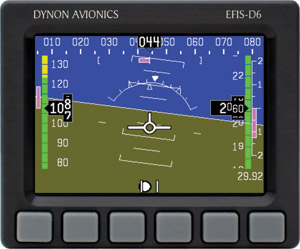
Dynon D6.
Dynon is slowly introducing features to SkyView units, which have been shipping since the first of the year. Essential attitude information and engine monitoring work now, as does the autopilot in most of the planned modes. Basic mapping was brought out at Sun n Fun. Airport and nav data will arrive soon to the moving map, as will flight-planning software. ARINC 429 integration is under development now; as it sits, SkyView talks to the Garmin SL30 and other GPSes through the RS-232 interface.
A cool feature of SkyView is the ability for the user to modify the position of the data fields or instruments on the engine monitoring screen. In fact, the possibilities for customizing all screens is a massive jump from what Dynon had before and arguably leads the industry.
Dynon has decided not to allow its system to interface with any external autopilots, so currently you must use its internal autopilot if you want the EFIS to control it. And Dynon faces the same problem as some of its competitors: the ability to keep up with demand due to overwhelming popularity.
The company’s legacy products remain in the lineup: The big-screen EFIS-D100, EMS-D100 engine monitor, the FlightDEK-D180 (think of a D100 and a D120 inhabiting the same box), plus the small-format EFIS-D10A and EMS-D10. Also in the catalog are two new EFIS products, the 7-inch-screen D60 (a simplified D100) and the D6 (a simplified D10A), both of which are excellent backup instruments.
Steins DIY installation rating: Dynons legacy systems are among the simplest to install in the market with no external modules other than the remote compass. Dynon provides engine monitor harnesses as standard and EFIS harnesses as options with the equipment. Mounting trays are also included with the 100/120/180 series, which make the physical installation straightforward (cut a hole, mount the tray, and insert the EFIS).
The new SkyView products are a bit more complicated to install relative to both Dynons legacy products and their competition. Additionally, the puzzling combination of AHRS/air data computer and remote compass make retrofit installations as well as installation in a tube/fabric aircraft challenging. You must find a place that is magnetically neutral, and you must run both pitot and static lines to the same location.
Garmin
Garmin pads its EFIS catalog, already filled with the G900X (an offshoot of the wildly popular G1000) and G500/600 systems, with the new G3X. News for G900X shoppers is that Garmin has increased features in the SVT (synthetic vision) as well as offering fully functional data recording and interfaces to more external units. The new Garmin GTS series traffic/ADS-B systems offer a competitive system for advanced traffic solutions that integrates well with the G900X.

This is a three-screen Garmin G3X suite in a Glasair II instrument panel-finally, something other than a Vans!
The G3X is arguably the easiest and cleanest of any Experimental EFIS to install, and has the lightest screens with the shallowest depth (1.5 pounds and 1.25 inches deep). Each screen comes complete with a built-in WAAS (non certified) GPS, and you can add multiple screens (up to three) to a system at a reasonable cost. Where most competitors systems require optional modules for items such as ARINC interfaces or weather, this is built into the screens of the G3X. The neat thing is that a builder can purchase the GPS (GDU) by itself and later upgrade it to a full-blown EFIS for no penalty in price. Garmin also recently released something it calls SVX (aka synthetic vision) for the G3X. Garmin SV is among the best in the business and naturally is derived from the company’s higher-end certified components.
Garmin also chose to partner with TruTrak Flight Systems to design a customized autopilot specifically for the G3X. After many months of R&D by both Garmin and TruTrak, flying the autopilot in the TruTrak company RV, the GX Pilot autopilot was born. The interface is well done and allows for full control of the autopilot through the EFIS along the lines of the higher-end G900- or G1000-equipped planes, while also maintaining a standalone autopilot that can be used independent of the EFIS if desired.
(For more on living with the G3X, see the sidebar below)
Steins DIY installation rating: On the G900X…just don’t do it yourself. This is a sophisticated box, and Garmin insists that the wiring be done by a professional shop to ensure a successful installation.
The G3X is the opposite-easy to install. The screens are compact, connectors are standard D-sub, and the setup is simple. Garmin even provides mounting nut rings for the panel to make the installation of the screens easier. At the moment, these systems must initially be wired by a professional just to ensure everything is set up correctly, but the physical installation in the aircraft is quite easy for a builder.
Grand Rapids Technologies
Grand Rapids Technologies, universally shortened to GRT, did not launch a complete new next generation system in the last year, but that is because it was ahead of the pack going into the year with its Horizon series, one of the first IFR-capable systems on the market. So GRT has the lead when it comes to synthetic vision in Experimental EFISes. Its fair to call the current offerings fully featured and comfortably mature. (There’s that term again.)
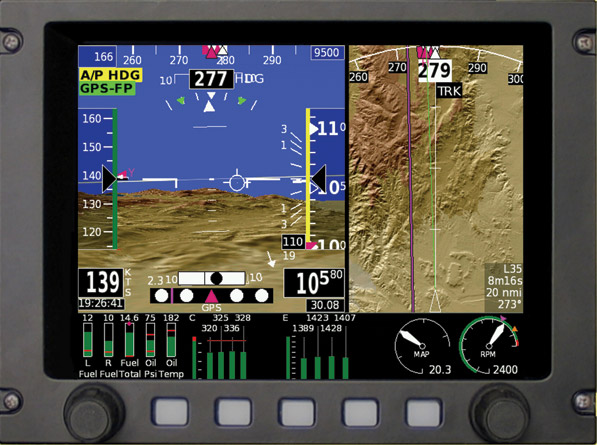
Grand Rapids Horizon HX showing the split screen (map on right, PFD left and engine monitoring along the bottom). You cant tell it apart from the Sport HX.
GRTs product offerings break down into the Horizon and Sport models, the primary difference being the location of the AHRS box. For the Sport, its internal, and for the Horizon its remote. Sports come in SX models, both with high-resolution screens (6.5 or 8.4 inches diagonally); this year, GRT offered a new SX with an upgraded processor, synthetic vision and many of the features of its top-line box for an extra $1200 over the SX base price
In the Horizon line, you’ll find the HS with a high-res screen in both the 8.4- and 6.5-inch sizes; the WS as a 6.5-inch wide-screen at lower resolution, and the HX, which has the high-res screens, faster processor, internal ARINC convertor and synthetic vision. All Horizon models can use either the single or double-sensor AHRS modules.
One facet of the GRT architecture thats probably unsurpassed in the industry is the sheer number and flexibility of its interface ports. There are more RS-232 serial ports than in a room full of Dells, and either optional or standard (depending on the specific system you buy) is a two-channel ARINC 429 interface to display all the nav information from boxes such as the Garmin GNS 430W.
While GRT doesn’t rebadge another autopilot or make its own, the models with the ARINC module can create synthesized GPSS (GPS Steering) and GPSV (GPS Vertical) commands to drive compatible autopilots. The GRT can command them to fly a heading, hold an altitude, climb to descent holding speed or vertical speed, couple to non-precision GPS approaches, precision GPS approaches and analog (VOR/ILS/LOC) signals. In addition, the GRT boxes have HITS (highway in the sky) and can create synthetic approaches to any runway found in the database.

A dual-screen Grand Rapids system in an RV-10 panel.
For engine monitoring, GRT uses an independent EIS module. It also offers XM weather and instrument approach plates (not yet geo-referenced), a flight director, flight path marker, synthetic approaches as well as data logging and all of the other features youd expect in a good EFIS. This year the company introduced something called derived AOA that uses a combination of GPS, attitude and airspeed to derive a fairly accurate angle of attack system.
My recommendation? Think about your mission. VFR pilots should check the Sport SX box, though it could work for IFR pilots, too, if you’re willing to forgo the option of dual AHRS modules, video input, approach plates, and live with fewer serial ports. Otherwise equally optioned, the Sport SX and a single-AHRS Horizon HX are $1850 apart. If you are building an IFR plane with multiple interfaces, buy an HX.
Steins DIY installation rating: The Sport is easier than the HX because it has the AHRS inside, but otherwise the installation is straightforward. Documentation is good, and all the connectors are standard-density D-sub; nothing bigger than a DB-25. The new GRT systems also use widely available computer Ethernet cables for connection to some items, which makes those particular boxes a breeze to install (XM weather, for example).
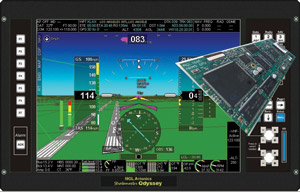
MGL Avionics Odyssey.
MGL Avionics
MGL Avionics in the past couple years has made inroads into heavier and larger Experimental aircraft. With the introduction of the Odyssey and Voyager EFISes (10.4 inches and 8.4 inches, respectively) MGL offers a truly competitive product. The Odyssey and Voyager have recently been upgraded with high-speed processors, which allow for multiple video inputs (for things like taxi and FLIR cameras) as well as having the unique capability of providing a standard video output. We’ve also been informed that MGL will be releasing a Generation III version of its EFISes complete with industry standard connectors on the back of the EFIS!
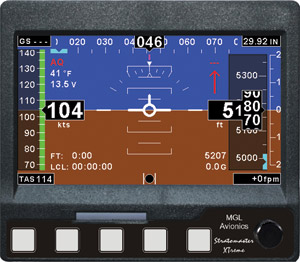
MGL XTreme.
MGL has standard interfaces to most external avionics including traffic solutions and ADS-B. At the moment the MGL boxes do not offer XM weather, because the company is waiting for ADS-B to provide it. MGL offers outputs to drive standard TruTrak and Trio autopilots. Instead of expending effort on autopilot interfaces, MGL has decided to design and implement its own autopilot. At press time, MGL was working on its own servos and should have some units in the field for flight testing shortly before production release to the general public. Overall, MGL is gaining in popularity by paying attention to what customers want, so there will likely be more and more units showing up in homebuilts here in the U.S. (MGL is already popular in Europe and Africa).
Its also worth noting that MGL is just beginning to ship its new XTreme EFIS, which looks to be a functional 4-inch unit. We don’t have any experience with this EFIS, but well report back when we get a chance to play with one.
Steins DIY installation rating: MGLs latest products are modular and require interfacing between each module/box attached to the EFIS. The move to industry standard connectors should make installation easier and generally increase the reliability of the system. The MGL screens are fairly shallow and do not take much space behind the panel.
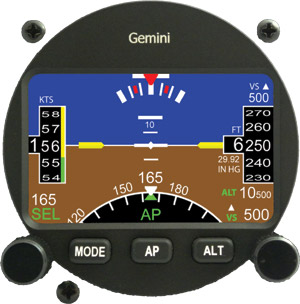
TruTrak Gemini AP 780.
TruTrak Flight Systems
TruTrak Flight Systems expanded on its known and popular line of autopilots by introducing its own EFIS. The philosophy of Jim Younkin is to design the best primary flight system available, and then use the industrys best components to complement his EFIS so as to provide an overall experience that is the best for core flying you could get. This means that the EFIS does not have a moving map, weather or many other interfaces for traffic and the like. It is designed to interface mainly with the Garmin SL30 for analog navigation (VOR/LOC/ILS) and a VFR GPS. There are ARINC 429 inputs in the autopilot-equipped model only to provide GPSS signals to the autopilot.
What it does have is perhaps the cleanest primary flight display (PFD) on the market along with some of the best autopilot software available. With the addition of its very low cost engine monitoring option, and when coupled with an industry-best map like the Garmin handhelds, you end up with a complete system that is quite good.
Naturally, the autopilot functionality is best when wired to a Garmin 430W or SL30 or other popular boxes to give fully coupled autopilot capabilities. TruTrak has recently announced a drastic price reduction for its EFISes, which makes them extremely attractive to many builders.
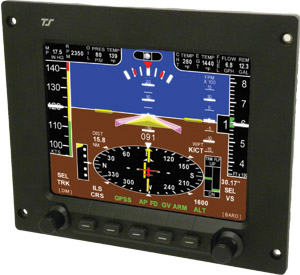
TruTrak SG.
At Sun n Fun this year, TruTrak announced a line of instruments that fits into a 3.125-inch instrument hole called the Gemini. The basic Gemini ADI replaces the company’s mechanical ADI (attitude direction indicator), which has had good reliability as a 2.25-inch instrument and much less so as the larger version. The new Gemini ADI is totally electronic. Building on that is the Gemini PFD, which adds airspeed and altitude to the ADIs attitude and track-based heading. There will be a Gemini engine monitor (EMS) and a Gemini with an autopilot built in. The first instruments are expected to arrive this summer, with prices starting at $1000.
Steins DIY installation rating: The TruTrak EFIS has no remote boxes other than an EIS (engine module) if you desire graphical engine monitoring. It uses GPS for heading information, so there is no remote compass to mount either. This makes the TruTrak 100% self-contained. Little wiring is required other than simple power, ground, GPS input, radio input and servo wiring if you want to have the EFIS drive an autopilot. TruTrak does offer a remote ARINC adapter (as do most other EFISes) for interfacing to popular boxes such as the Garmin GNS 430W. Its available with an overlapping-bezel mount, a diagonal-corner mount and a radio-stack mount.

